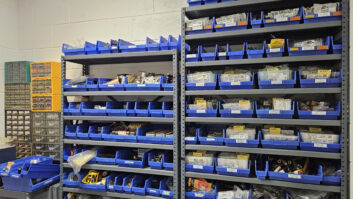If there’s a topic that gets Workbench readers talking, it’s critters at the transmitter site.
Bob Meister in Hamden, Conn., read about the infestation of field mice in an electrical panel (Feb. 1 issue). He shared some additional “before” photos and described how he put an end to an infiltration five years ago at a station he serviced.

Fig. 1: The inside of an ATU makes a perfect home for rodents.

Fig. 2: Urine can damage the ATU components, as can nesting material.
Bob was helping to clean out an AM antenna tuning unit enclosure on a nighttime-only tower. This ATU is about 3x3x3 feet and must weigh 300 pounds. It’s elevated on bricks inside a rebuilt elevated doghouse.
All of the wires and cables — RF coax, 240V for the phasor contactor coils, low-voltage wiring for the tally and interlock circuits — come through holes in the bottom of the cabinet. You can see the coax coming in near the bottom of Fig. 1 next to the box of mouse bait, which the mice apparently enjoyed.
Additional wires enter at the rear of the ATU, below the contactor, behind the coil labeled L-14. The mice just climb up the wires and cables, through the holes in the bottom of the cabinet, and have a nice dry home for the winter. You can see one mouse that didn’t make it in the second photo (Fig.2), next to the Delta TCT RF sampling transformer.
The beautiful aqua color of the copper ground strap under the tower lighting choke is “patina” caused by rodent urine. It was pungent when Bob opened the door and started vacuuming out the nests.
After he cleaned the ATU with a small inexpensive shop vac (which he threw into the dumpster afterward), he sealed the two 1-1/2-inch entry holes from underneath using three layers of overlapping 2-inch-wide aluminum foil tape — the kind of tape that should be used on duct work, not the gray cloth/vinyl tape that’s commonly called duct tape. Bob wrapped a layer of tape down each cable as well. He could barely reach the hole at the rear of the ATU. The metal is fairly thick but would not have supported steel or copper wool, much less spray foam. Bob didn’t bother with tape on the inside.
Five years later, there’s no sign of mice inside the cabinet or, for that matter, the doghouse.
***
Technical consultant Lewis Dye Collins also commented on the rodent nest we showed that had been hidden behind an electrical box panel.
Lew writes that every transmitter engineer should trot down to the closest Harbor Freight store (www.harborfreight.com) and purchase an infrared thermometer. It doesn’t cost much and is useful for all sorts of things. It can be used to diagnose “hot” connections inside circuit boxes, coaxial elbows or transfer switches, or blower/fan motors.
***

Fig. 3: The FLIR One fits in the palm of your hand …

Fig. 4: … and provides a visual display of heat-generating components.
With that in mind, Second Opinion principal engineer Greg Dahl writes about an add-on for your smartphone or tablet. Manufactured by FLIR (www.flirone.com) and seen in Fig. 3, the FLIR One is a plug-in module that turns your iOS or Android smartphone or tablet into a thermal imaging camera for under $250.
Fig. 4 shows an engineer’s arm pointing to a heat-producing transformer inside a generator transfer panel. Using the video mode permits a “moving” video image of the systems under inspection. The hotter the source, the whiter the viewed image.
Imagine filming the inside run of your rigid transmission line, monitoring the heat of elbows and bullets … then comparing the results every six months to a year, in order to spot heating trends. Another diagnostic idea is to stand in the transmitter room and “view” all conduit, electrical boxes or equipment. You can also measure hot spots inside an AM phasor or ATU.
Contract engineers should consider this as a service to be provided to customers. The fact that the image can be saved makes the results especially useful. Don’t limit the measurements to the transmitter site. Viewing studio electric boxes and air conditioners/compressors/air handlers can spot trouble before a massive failure occurs. The cost of the module can be recouped from the first job, with subsequent jobs being highly profitable.
Check with the station’s insurance company to see if this kind of service would reduce insurance premiums. If so, that’s another incentive for the station to pay you for this service. Larger contract firms may want to offer the service to members of state broadcast associations.
Contribute to Workbench. You’ll help your fellow engineers and qualify for SBE recertification credit. Send Workbench tips to [email protected]. Fax to (603) 472-4944.
Author John Bisset has spent 48 years in the broadcasting industry and is still learning. He handles West Coast sales for the Telos Alliance. John is SBE certified and is a past recipient of the SBE’s Educator of the Year Award.











